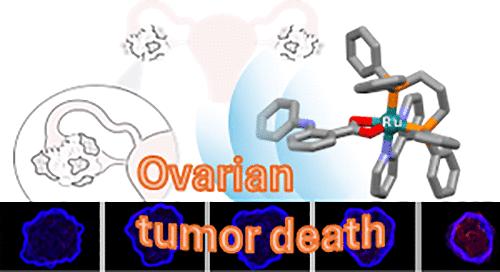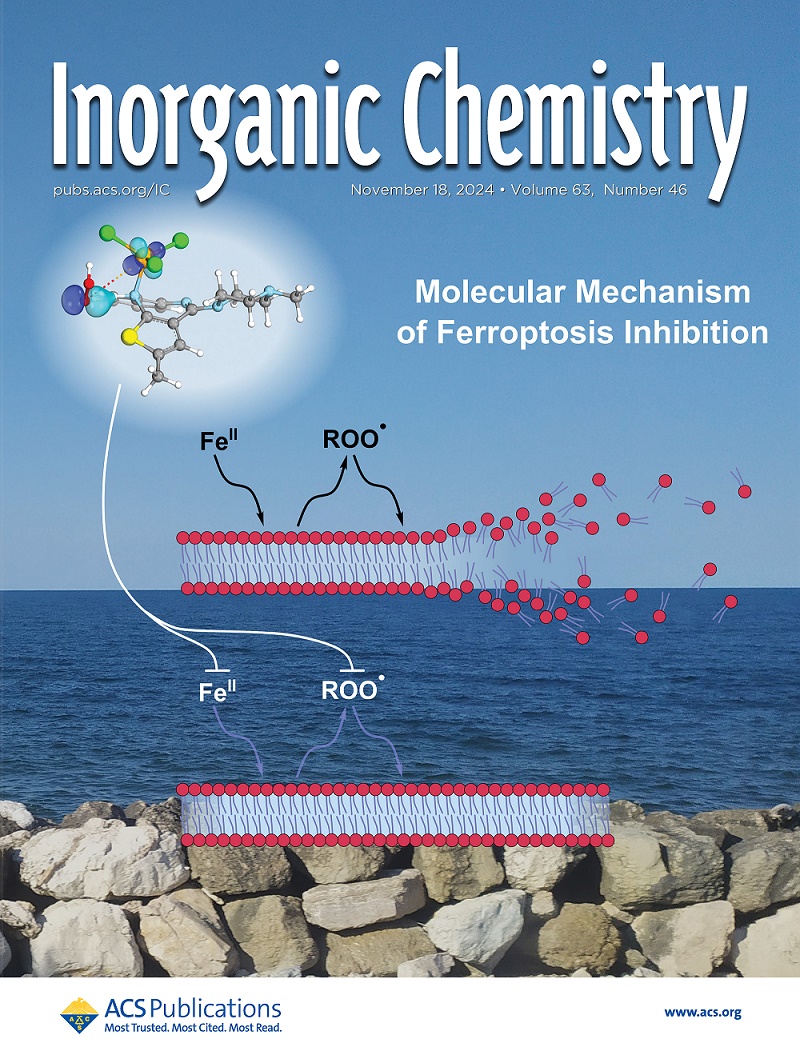IF 4.3
2区 化学
Q1 CHEMISTRY, INORGANIC & NUCLEAR
引用次数: 0
摘要
癌症对顺铂(cisplatin)等化疗药物的耐药性是一项重大挑战,会导致治疗失败和疗效不佳。新型金属基化合物为克服耐药性和提高疗效提供了一种前景广阔的策略。我们合成了四种 Ru(II) 与氨基甲酸衍生物的配合物,并对其进行了表征:[Ru(L)(bipy)(dppp)]PF6,其中 L 代表非那米酸(HFen,复合物 1)、甲非那米酸(HMFen,复合物 2)、托芬那米酸(HTFen,复合物 3)和氟非那米酸(HFFen,复合物 4)。摩尔电导率、元素分析、傅立叶变换红外光谱、紫外-可见光谱、质谱分析以及 31P{1H}、1H 和 13C 核磁共振证实了它们的组成,复合物 1 的晶体结构通过 X 射线衍射得到了证实。与 MDA-MB-231(乳腺癌)和 A549(肺癌)相比,复合物 1-4 对测试的细胞系,尤其是 A2780 和 A2780cisR(顺铂抗性卵巢肿瘤)表现出显著的细胞毒性。机理研究显示,通过次要沟槽或静电结合进行的 DNA 相互作用较弱。细胞摄取试验显示,复合物 1(3.6%)和 2(4.5%)能有效内化,与强效 IC50 值相关。这些复合物还能改变 A2780 细胞的形态、降低细胞密度并抑制其集落形成。染色检测表明,这些复合物可诱导细胞死亡和细胞器损伤,从而凸显了它们作为抗肿瘤药物的潜力。本文章由计算机程序翻译,如有差异,请以英文原文为准。

Ru(II)-Fenamic-Based Complexes as Promising Human Ovarian Antitumor Agents: DNA Interaction, Cellular Uptake, and Three-Dimensional Spheroid Models
Cancer resistance to chemotherapeutic agents such as cisplatin presents a significant challenge, leading to treatment failure and poor outcomes. Novel metal-based compounds offer a promising strategy to overcome drug resistance and to enhance efficacy. Four Ru(II) complexes with fenamic acid derivatives were synthesized and characterized: [Ru(L)(bipy)(dppp)]PF6, where L represents fenamic acid (HFen, complex 1), mefenamic acid (HMFen, complex 2), tolfenamic acid (HTFen, complex 3), and flufenamic acid (HFFen, complex 4). Their composition was supported by molar conductivity, elemental analysis, Fourier transform infrared spectroscopy, ultraviolet–visible spectroscopy, mass spectrometry, and 31P{1H}, 1H, and 13C nuclear magnetic resonance, with the crystal structure of complex 1 confirmed via X-ray diffraction. Complexes 1–4 exhibited notable cytotoxicity against tested cell lines, particularly A2780 and A2780cisR (cisplatin-resistant ovarian tumors), compared to MDA-MB-231 (breast) and A549 (lung) lines. Mechanistic studies revealed weak DNA interactions through minor grooves or electrostatic binding. Cellular uptake assays showed effective internalization of complexes 1 (3.6%) and 2 (4.5%), correlating with potent IC50 values. These complexes also altered cell morphology, reduced cell density, and inhibited colony formation in the A2780 cells. Staining assays indicated induced cell death and organelle damage, highlighting their potential as promising antitumor agents.
求助全文
通过发布文献求助,成功后即可免费获取论文全文。
去求助
来源期刊

Inorganic Chemistry
化学-无机化学与核化学
CiteScore
7.60
自引率
13.00%
发文量
1960
审稿时长
1.9 months
期刊介绍:
Inorganic Chemistry publishes fundamental studies in all phases of inorganic chemistry. Coverage includes experimental and theoretical reports on quantitative studies of structure and thermodynamics, kinetics, mechanisms of inorganic reactions, bioinorganic chemistry, and relevant aspects of organometallic chemistry, solid-state phenomena, and chemical bonding theory. Emphasis is placed on the synthesis, structure, thermodynamics, reactivity, spectroscopy, and bonding properties of significant new and known compounds.
 求助内容:
求助内容: 应助结果提醒方式:
应助结果提醒方式:


